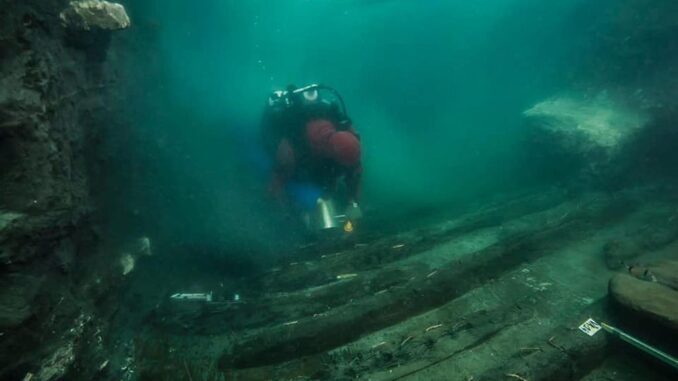
Archeologists discovered Greek treasures that include a funerary site while searching for new parts of the submerged Egyptian city of Heracleion, once the largest port in Egypt.
The find took place in the Abu Qir Bay region in Alexandria, on the Mediterranean coast in northern Egypt.
The underwater excavation was a French and Egyptian mission led by the European Institute for Underwater Archaeology (IEASM).
Heracleion, better known by its original and Egyptian name Thonis, sometimes called Thonis-Heracleion was discovered underwater in 2000, after more than 2,000 years. The old city was sunk and all that is left can now be found 15 miles, under just 30 feet of water in Abi Qir Bay.
The newly discovered sunken vessel measured more than 82 feet and had a flat bottom and a large sail, useful for navigating the Nile River and Delta.
“Our preliminary study shows the hull of this galley was built in the Classical tradition and relied on long mortise-and-tenon joints and well-developed internal structure, said Franck Goddio, the head of the European Institute for Underwater Archeology (IEASM) in a press release.
“However, it also contains features of ancient Egyptian construction and allows us to speak of a mixed type of construction. It was a rowing ship that was also furnished with a large sail, as shown by a mast step of considerable dimensions. This longboat was flat-bottomed and had a flat keel, which was quite advantageous for navigation on the Nile and in the Delta.
“Some typical ancient Egyptian shipbuilding features, together with the evidence for reuse of wood in the ship, indicating it was built in Egypt,“ Goddio said.

The ancient military vessel had been pinned to the bottom of a deep canal after huge blocks from a temple to Amun, the ancient Egyptian god of the sun and air, fell on it after a cataclysmic event during the second century B.C., according to a statement released by the Egyptian Ministry of Tourism and Antiquities,
Ayman Ashmawi, the head of the Egyptian archeology sector, said the remains of the vessel were found under about 16 feet of solid clay mixed in with debris from the temple. The excavators used cutting-edge technology, including a sub-bottom profiler, to scan sediment and rock beneath the seafloor that helps detect shipwrecks.
Franck Goddio (IEASM) said the discovery was a rare find. It is unusual to find vessels dating back to that era.
Goddio said Greek vessels of this type were unheard of until a vessel called the Bouniqia Marsala, which dates back to about 235 B.C., was discovered.
The funerary area dates back to the fourth century B.C. and is located near the entrance to what was a northeastern channel into the ancient city, according to Professor Ehab Fahmy, head of the central administration of sunken monuments.

The new findings show the presence of Greek merchants who lived in the city at the time, permitted by the pharaohs of the era to settle there.
It also confirms the Heracleion was Egypt’s largest port in the Mediterranean at one time and predates Alexandria, which was founded by Alexander the Great in 331 B.C.
During the second century B.C., Heracleion was surpassed by Alexandria, which became Egypt’s main port. Around this time that a combination of rising sea levels, tsunamis and earthquakes spelled the demise of the city. By the 8th century A.D., the entire city had sunk.
Edited by Angie Ivan and Fern Siegel
The post Savers Of The Lost Ark: Ancient Greek Warship Found Buried Under The Sunken City Of Herakleion appeared first on Zenger News.
